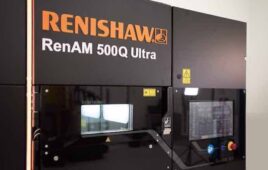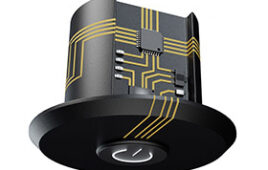Substantial legal requirements have resulted in more complex specifications for implant manufacturers: From the design through production, the complete process chain must be documented and validated. CNC-controlled machines support prosthetics manufacturers and permit high-quality products to be manufactured, despite being subjected to continuing high cost pressures.
The idea for a new medical implant normally arises to meet a practical need. It is a long process before the implant can be produced in quantity; it takes approximately 12 to 18 months from first drawing, to design and job planning, and through to the completed, approved implant. “After receiving a request for a new product from an orthopedist, we first design and develop a prototype”, said Hans-Joachim Mahr, production manager at implantcast Corp. in Buxtehude, Germany. “The CNC controller assumes an important function for the transfer of the CAD/CAM data to the actual production. It supports the idea and the virtual model in a workpiece that the orthopedist then can hold in his hands for the first time.”
 Artificial bones made of titanium are mainly manufactured using the stock-removal process. At implantcast, for example, the production of hip implants runs on DMG turning-milling centers equipped with the Siemens CNC Sinumerik 840D sl.
Artificial bones made of titanium are mainly manufactured using the stock-removal process. At implantcast, for example, the production of hip implants runs on DMG turning-milling centers equipped with the Siemens CNC Sinumerik 840D sl.
Each implant also has an associated, specially-tailored set of instruments required for the implantation. This includes, for example, a surgical rasp used to prepare the bone.
Because its machine functionality is suitable for both complex single parts and large production runs, the fast data processing of the 840D sl is a particular advantage for the standard implants produced in quantity. implantcast also offers, for particularly complicated applications such as cancer patients, the manufacturing of patient-specific implants. In this case, the implants and instruments are cut precisely to the associated bone structure with the help of a CT or MRI picture. For this single part production, implantcast uses the setup functions of the Sinumerik that permit the fast machine setup.
For example, the CNC user interface has self-explanatory icons that can be configured as popular keys. Furthermore, many functions are available that assist in the measuring of tools and workpieces. These measuring functions can be used both for the setup and process measurement, that is, the overall quality assurance during the machining. The Sinumerik Operate user interface also integrates simple swivel commands that simplify the machine setup. The swivel functions are available both for the swiveling in a machine axis and also in an axis of the workpiece coordinate system. The CNC also handles any required coordinate transformation.
Whether a one-off component or a quantity run, the highest demands are placed on each individual medical engineering workpiece. It’s obvious that there can be no letdown permitted from quality and precision standards. Furthermore, the manufacturer is responsible for validating the complete production process, which means that even prototype construction must satisfy the same conditions as the subsequent volume runs.
 Artificial hip sockets in twelvestandard sizes
Artificial hip sockets in twelvestandard sizes
The number of artificial bone implants is increasing continually, while operations such as the use of a replacement hip made of titanium also belong to the standard daily program in orthopedic surgery today. In 2010, one million artificial hip and knee joints were implanted in the U.S. Forecasts expect this number to exceed 4 million by 2030. This number, however, does not obviate the fact that the highest demands are placed on each individual medical implant, whether a one-off or production run.
Standard implants are now available in various sizes as required for the physique of the patient. The NC programming that defines the functions for machining the workpiece is fast. The Sinumerik 840D sl provides a range of turning and milling cycles. Because all operator functions and cycles are supported with animated elements, the operator intuitively knows how the function is to be used, without needing to consult the instruction manual. Dynamic vector graphics can be used when the animated elements do not suffice to explain the purpose of the individual input values, such as the parameterization of complex cycles. These graphics reflect the current input values with their proportional representation.
At EMO 2011 in Hanover, Germany, Siemens presented dual-channel production of bone rasps on machines with two slides. This allowed turning-milling centers such as the DMG CTX alpha 450TC to be operated more effectively, because the complete programming functionality is available in both channels. The Programsync function synchronizes the machining channels, whether or not the programs have been programmed in DIN/ISO.
The increasing complexity of the turning-milling machines and the possible production programs also increase the risk of programming errors that, under some circumstances, can cause machine damage. For this purpose, the Sinumerik 840D sl offers a program simulation that shows the stock removal process in virtual 3D. In addition to the complete representation of the cutting actions, the expected machining time corresponding to the programmed technology values is also displayed, before the production of a single workpiece.
A short machining time, however, is critical for production economy. The turning-milling center with the 840D sl used at implantcast, with cross slides for Y and B axes, permits 5-axis simultaneous machining. The implants are manufactured here in a single operation, with parallel machining on the main and counter spindles. For the complete machining, the Sinumerik 840D sl provides turning-milling functions that can be used in combination.
Bone rasps are an example of complex workpieces, because their basic form represents a significant challenge in machining, namely, a rasp body with many rasp teeth located on the contoured outer surfaces. The Sinumerik MDynamics technology package ensures the required surface quality at high machining speed; even for difficult materials, the “Advanced Surface” motion control produces milling results that meet the stringent requirements placed on medical implants and instruments.
Each individual part is subjected to quality control. Sensing probes check the accuracy of the contour and the peak-to-valley height and scan the surface for even the smallest damage. To check the material structure, X-ray examinations are also made on some parts. Only when all these hurdles have been overcome are the implants passed to the internal department at implantcast for sterile packaging and subsequent shipping.
A patient with bone prostheses receives a prosthesis pass. This document allows the complete manufacturing process of the prosthesis to be reconstructed at any time. Whereas in other industry sectors, such as the automotive or food processing industry, products must be able to be tracked batch-related; this tracking requirement in the orthopedic world is specific to each individual patient’s medical implant. This is a major challenge, considering implantcast produces about 3,000 items, each week.
Despite the use of sophisticated technology, at the end of the process chain there is still a suffering patient who must be helped. There is a difference between manufacturer medical industry parts and making those for machinery construction. For example, when Hans-Joachim Mahr himself delivers a package to the post office, the trip is not actually part of his job. “The patient whose prosthesis is in the package would need to wait one day longer for his/her operation, were we not to act immediately,” explained Mahr.
For such late requests, and these are not infrequent, it is quite possible that he will personally start the prosthesis on its journey to a patient in need.
Siemens
usa.siemens.com/cnc
Filed Under: Hose • wraps + sleeves, 3D printing • additive • stereolithography





Tell Us What You Think!